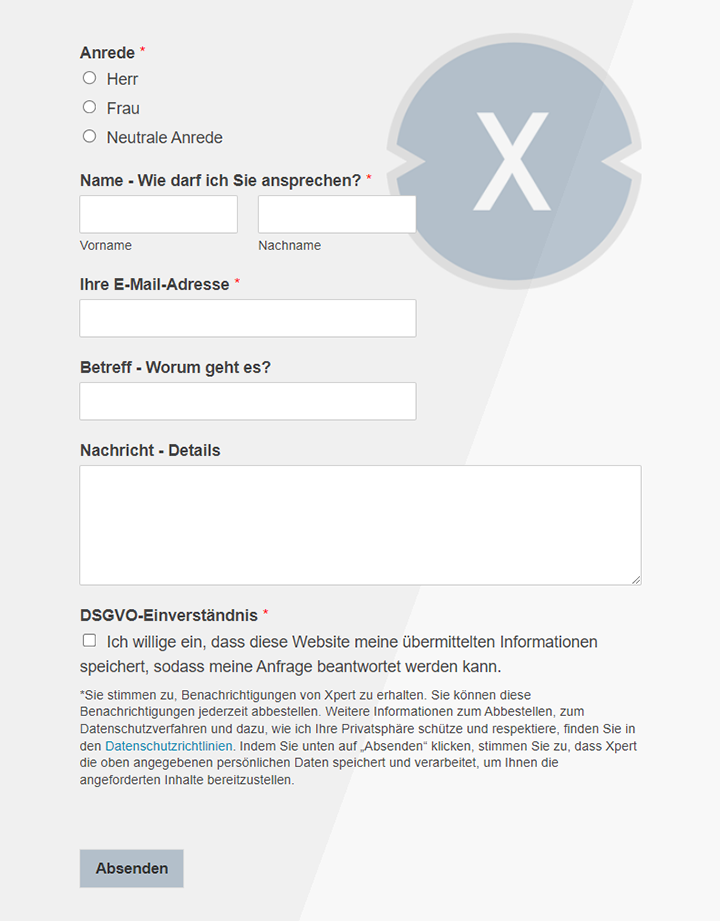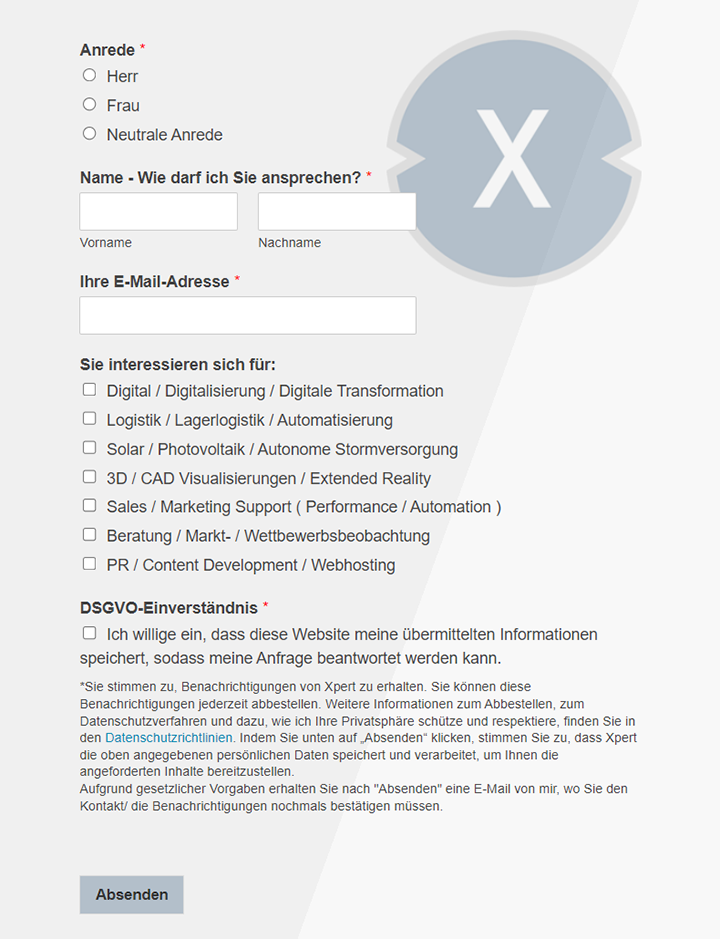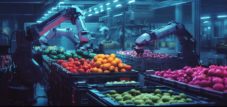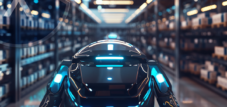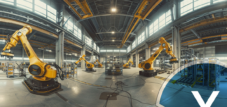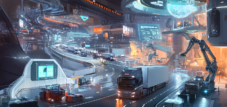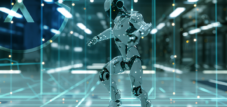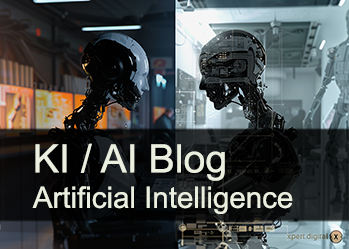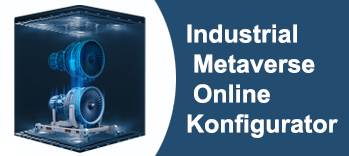Robotics and automation: a comprehensive analysis of applications, trends and social effects
Xpert pre-release
Language selection 📢
Published on: April 10, 2025 / update from: April 10, 2025 - Author: Konrad Wolfenstein

Robotics and automation: a comprehensive analysis of applications, trends and social effects Image: Xpert.digital
The future with robotics: How Automation revolutionizes our world
The focus: Robotics and Automation in Europe focus
Robotics and automation are much more than just keywords today - they are the driving forces behind a profound change in business, society and our daily life. From the way products are manufactured and services are provided, to our workplaces and the way we interact with each other, robotics and automation redesign our world at a rapid pace.
This comprehensive report illuminates the core concepts, diverse areas of application and cross -sectoral effects of robotics and automation, with a special focus on Germany and Europe. We will deal with the key technologies that drive this revolution forward, such as artificial intelligence (KI), collaborative robots (cobots), autonomous systems and humanoid robots, and examine the opportunities and challenges that are associated with them.
We will examine the effects on different sectors, from logistics and production to construction and healthcare to education, mobility and agriculture. After all, we will analyze the advantages and disadvantages of these technologies and ask the crucial question: How can we use robotics and automation responsibly to shape a future that is both economically successful and socially just?
Suitable for:
- The AI-controlled robotics and humanoid robots: hype or reality? A critical analysis of the market maturity
Robotics and automation - definition and demarcation
The terms robotics and automation are often used synonymously, but it is important to understand the fine differences between them in order to fully grasp the scope of their effects.
Core concepts and principles
Automation
In essence, Automation refers to the use of technology in order to control and carry out processes or procedures without or with minimal human intervention. This can be done through mechanical, electronic or computer-aided systems and aims to carry out tasks partially or fully autonomously. The main goal of automation is to improve efficiency, consistency and security.
Automation is by no means a new concept. Think of assemblies in factories or computer -controlled machines that perform precisely. But modern automation goes far beyond these traditional examples. It now also includes the automation of digital processes through software, such as Robotic Process Automation (RPA), which automates repetitive tasks in the office.
In Germany, standardization bodies play a crucial role in the definition and standardization of automation methods and processes to ensure that systems work safely and efficiently.
robotics
Robotics is an interdisciplinary science and engineering discipline, which deals with the design, construction, operation and use of robots. It integrates knowledge of mechanics, electronics, computer science and math to create intelligent machines that are able to perform tasks autonomously.
A robot is essentially a system that can perceive its surroundings, make decisions and carry out actions. Modern robots use sensors to collect information about the environment, actuators to carry out movements or actions, and complex control systems to make decisions and coordinate actions.
The International Federation of Robotics (IFR) fundamentally distinguishes between industrial robots that are primarily used in production, and service robots that provide services for humans or institutions.
robot
A robot is a physical or virtual unit that interacts with its environment. Physical robots use sensors to collect information about the environment, actuators to carry out movements or actions, and systems for information processing that make decisions and control actions. You can replace people in physical tasks or when making decisions. Industrial robots are designed for use in production, while service robots provide services for people or institutions. There are different designs such as Cartesian, Scara, Delta, Knickarm or Collaborative robots that differ in their joints and movement axes. In addition to the robot arm itself, a functional robot system also requires end effectors (gripper, tools), control, sensors and safety measures.
Robotic Process Automation (RPA):
In contrast to physical robots, RPA is software applications that imitate human interactions with the user interfaces of software systems. RPA bots carry out regular, repetitive digital tasks such as filling out forms, copying data or processing information from structured documents. They work around the clock, flawlessly for routine tasks and cheaper than human workers for these specific activities. RPA is therefore a form of process automation in digital space.
Service
This field includes robots that provide partial or fully autonomous services outside of industrial production, be it for human well-being or for institutions. A distinction is made between professional service robots that are operated by trained staff (e.g. logistics car robots such as AMRS, medical robots), and personal or domestic service robots used by laypersons (e.g. dusting robot). Central research and development areas are perception, navigation, manipulation, human-robot interaction (MRI) and security.
Core principles
Robotics and automation are based on a number of core principles, including:
- Perception: The ability to grasp the environment through sensors such as cameras, lidar and strength sensors.
- Navigation: The ability to move and localize in the area.
- Manipulation: The ability to physically interact with objects by griffan or tools.
- Control and regulation: the ability to control movements and actions.
- Security: the guarantee of a safe operation, especially near people.
- Autonomy: The ability to perform tasks without human interventions.
- Intelligence/cognition: Learning the ability to make decisions and adapt to changed conditions, often realized by AI.
Relationship and synergy between robotics and automation
Robotics and automation are closely connected and complement each other. Robotics are often the means of realizing automation in the real world, especially when it comes to automating physical tasks. Automation is the overarching concept that describes the use of technology to control processes.
An automated robot system integrates various components - the robot itself, sensors, controls, software - to carry out a task independently. Synergy is that the robotics provide physical ability to act (action), while automation technology, which is increasingly based on software, control systems and AI, which provides intelligence, coordination and control. RPA automates digital work processes, physical robots automate physical processes; Both fall under the generic term of the automation.
However, the boundaries between the terms are increasingly blurred, especially due to the advance of AI and software -defined systems. Modern robotics often include inherently highly developed automation functions, and vice versa, advanced automation systems often integrate robotic elements, be they physical robot arms, mobile platforms or software bots. The focus shifts from the pure form (hardware vs. software) towards the ability - the autonomous execution of tasks. “Intelligent Automation” thus becomes a higher -level topic that is realized by various technologies.
At the same time, the concept of robotics is expanding. This reflects a functional view that is based on the ability to make autonomous tasks, driven by the underlying automation and AI technologies. This conceptual expansion requires a precise definition in the respective context (e.g. industrial automation vs. Servicerobotics vs. process automation).
Suitable for:
- Humanoids, industrial and service robots on the upswing- humanoid robots are no longer a science fiction
Cross -sector applications and effects
Robotics and automation are not limited to a single industry, but are used in a growing number of sectors. However, the specific implementations and effects vary depending on the industry.
logistics
General role & applications
The logistics industry, which makes up about 10% of global GDP, faces the challenge of countering the shortage of skilled workers, increasing efficiency and improving accuracy in warehousing, transport and delivery. Automation is the key here.
Typical applications include material transport through driverless transport systems (FTS/AGV) and autonomous mobile robots (AMR), picking (picking), packaging, sorting, palleting and deppting as well as loading and unloading trucks or pallets. Software such as Warehouse Management Systems (WMS) and Transportation Management Systems (TMS) plays a central role in controlling and optimizing these processes.
Case study Nespresso
The coffee capsule manufacturer Nespresso uses automation solutions in its distribution center to process e-commerce orders. Robot portray coffee boxes, while other robots take over the pecking and packaging of the customer orders. The system enables a high throughput and significantly reduces the error rate.
Nespresso also generally invests in technology, for example for supply chain transparency using a blockchain or to improve customer service by power app. Production takes place in highly automated works in which considerably invested.
Effects
Automation in logistics leads to significant increases in efficiency, accuracy, productivity and scalability. It enables cost reductions, improves the quality of order processing and helps to counteract the shortage of workers. It enables faster delivery times, especially in e-commerce.
The logistics automation develops away from simple support and sorting systems towards more intelligent, more flexible systems. Autonomous mobile robots (AMRS) and AI-supported picking robots can better deal with the high variability and speed requirements of e-commerce and omnichannel trade. In addition to advanced hardware, this also requires highly developed software such as WMS and AI for orchestration. This development reflects a transition to integrated, intelligent systems that manage complexity instead of only performing simple repetitions.
Despite the advantages, high initial investments and the complexity of the implementation remain hurdles, especially for small and medium -sized companies (SMEs). This leads to the development of alternative business models such as Robotics as-as-a-service (RAAS), in which companies can rent automation capacities or pay for usage-based, which lowers the entry barrier.
Industry & production
General role & applications
Industry and production is the historical core area for the use of robotics. Robots are performing tasks here for people monotonous, dirty, dangerous or high -precision (the “4 d's”: Dull, Dirty, Dangerous, Delicate/Dexterous). The main applications include material handling, assembly, welding, painting, grinding, polishing, milling, machine folding and quality check.
Robotics and automation are decisive drivers for productivity, quality, efficiency, flexibility and competitiveness in production. They are central elements of Industry 4.0 and enable concepts such as the “Smart Factory”.
Case study Estonia
The country is pursuing an ambitious strategy for the digital transformation of its industry, supported by state support programs for the introduction of automation, digital technologies and robotics, including employee training. Estonia positions itself as a “E-Estonia”, a highly digitized country, and wants to use this strength to make its industry more competitive.
Case study Endress+Hauser
As a global provider of measurement and automation technology for the process industry, Endress+Hauser himself uses intensive automation and robotics in its production facilities. Production follows lean and kaizen principles, uses the latest manufacturing technologies and high-precision calibration systems to efficiently produce a high variety of variants.
Case study China
China has carried out an unprecedented catch -up in industrial automation and overtook Germany and the United States in the robot density. This is the result of massive state investments and subsidies, strong internal demand and increasing wage costs. China is the world's largest market for industrial robots and installed over half of all new robots worldwide in 2022. The country is now also aiming for the leadership role in mass production by humanoid robots by 2027.
Case study Infineon
The semiconductor manufacturer Infineon is both an important user of robotics in its own highly automated factories (FABS) as well as an important supplier of key components (sensors, power construction elements) for the robotic industry.
Effects
Automation in industry leads to significant increases in productivity, efficiency, quality and security. It reduces costs, reduces committee and throughput times and increases flexibility. It enables the production of complex products and can help to counteract the shortage of skilled workers. In addition, it is seen as a means of relocating production capacities (Reshoring/Nearshoring) and securing competitiveness.
Automation in production develops beyond simple, repetitive tasks. Driven by AI, advanced sensors and the requirements of Industry 4.0 (personalized production, lot size 1), the trend is towards cognitive and flexible robot systems. These need a higher level of autonomy and adaptability in order to be able to react to variants, tolerances and unforeseen events.
While large companies, especially in the automotive industry, cited early adaptation, the focus is increasingly being able to make automation accessible and economical for small and medium -sized companies (SMEs). This is done through more user-friendly programming concepts (low code/no-code, teaching by demonstration), cheaper robots (low-cost robotics) and new business models such as RAAS.
Construction
General role & applications
The construction industry, traditionally asserted as conservative and labor -intensive, increasingly begins to adapt robotics and automation. Drivers are the lack of specialists, the pressure to increase efficiency, security concerns and sustainability goals. Applications include the automated walls, welding, drilling, material transport and the handling of heavy loads, demolition and recycling robots, 3D printing of components or entire buildings, inspection and surveillance using drones or robots, autonomous construction machinery for earthworks and road construction as well as exoskeletons to support workers in physically difficult activities.
Case study Wirtgen Group
The company offers an integrated system for road construction that uses digital terrain models and automates machine control. With GNSS/RTK positioning, milling depth, inclination, steering of the finishing and the position of the plane are controlled precisely and automatically. For rabbits, Wirtgen offers a GPS/GNSS-based system for the leading wireless installation of concrete profiles.
Case study Moba Mobile Automation
MOBA specializes in automation solutions for mobile work machines in construction, such as asphalt -ready, excavator, grader and wheel loader. For road construction, they offer leveling systems that can automatically regulate the height and inclination of the Bohle and work with various references. In earthworks, the portfolio of excavator controls as well as controls for graders and caterpillars that help the driver work precisely according to plan and to significantly increase efficiency.
Effects
The use of robotics and automation in construction promises significant advantages: increased efficiency, acceleration of construction processes, higher precision and constant quality, improved occupational safety by taking on dangerous activities, reducing costs (work, material, rework), reduction in material waste and better use of resources. You can also help to counter the shortage of skilled workers and enable new, innovative construction processes such as 3D printing.
Automation in construction faces special challenges that differ from those in controlled factory environments. Construction sites are typically unstructured, dynamic and rough environmental conditions. This requires robot systems to have a particularly robust perception of their surroundings, reliable navigation under difficult conditions and high adaptability itself and interaction with human workers.
Despite the considerable potential for increasing efficiency and reducing costs, the high acquisition costs for specialized construction robots and the need for qualified personnel for operation and maintenance remain significant hurdles for wide adaptation, especially for smaller construction companies.
Healthcare & care
General role & applications
Robotics and automation are becoming increasingly important in the health and care sector to improve patient care, to make surgical interventions more precisely, increase operational efficiency, relieve the staff and support an independent life in old age or disabilities.
The application spectrum is wide: surgical assistance, logistics and transport, cleaning and disinfection, patient handling and mobility support, diagnostics, automation of pharmacy, social and accompanying robots as well as telepotes and remote monitoring.
Example geriatric care fair
This trade fair shows current trends for the care industry. This includes social robots for the entertainment and excitation of seniors, serving robots, exoskeletons for walking support, electrical lifting and upstream aids as well as AI-based software for relief for administrative tasks.
Example Köpenick (Social Foundation)
The Köpenick Social Foundation introduced the social robot “Willi” in a senior center to promote the social participation of the residents. The use is accompanied scientifically to examine the effects on well -being. In Berlin there are other initiatives, such as the startup editor with the robot “Oscar”, which monitors residents in nursing homes at night, or the Caritas Clinic Dominikus, which uses a spine robot for high-precision operations.
Example Leipzig (Avatar project)
Various initiatives in Leipzig use telepresence robots that act as “deputies” for long -term children and adolescents who cannot physically take part in school lessons. Via a tablet, the children can control the avatar in the classroom, follow the lessons, report, speak to classmates and even virtually take part in school trips.
Effects
Robotics in healthcare enables precise and less invasive operations with potentially faster recovery. It increases efficiency in logistics, cleaning and pharmacy activities. Physical stress for the staff can be reduced. Robots can help to cushion personnel bottlenecks and increase patient safety. Assistance and social robots can promote independence and social participation.
The adaptation of robotics in health and care shows a division of two: on the one hand, there are highly developed, expensive surgical systems that are established in specialized clinics but require high investments. On the other hand, increasingly cost-effective assistance and service robots for logistics, social support or telepresence are created. However, these face challenges in integration into complex human environments, user acceptance and the proof of their cost efficiency and their actual benefits.
Ethic considerations of outstanding importance are particularly important in the health and care sector. Questions of patient safety, data protection, the risk of loss of human proximity and empathy as well as the ensuring that technology serves and replaces non -essential human interaction, the development and implementation must be carefully taken into account.
Education
General role & applications
Robotics are used in two ways in the education sector: as a teaching aid and as supporting technology. As a teaching material, it serves to impart students and students from the MINT subjects (mathematics, computer science, natural sciences, technology). As supportive technology, robots, in particular telepresence avatars, students with long-term diseases or disabilities, enable participation in the lessons and social life of the school from a distance. In the future, AI-based robots could also be used as personalized tutors or learning companions.
Example Hennigsdorf
Lego robot kits are used here in a computer AG or MINT workshop to enable children and adolescents from 10 years of age to make practical experience with robotics and programming. The AGs take part in competitions such as the World Robot Olympiad (WRO).
Example Leipzig (Avatar project)
As described in the Health Care/Care section, initiatives in Leipzig use telepress robots to enable long -term patients to participate virtual participation in lessons and school life.
Effects
Robotics in the field of education can increase the interest in MINT subjects and promote important future skills (programming, critical thinking, collaboration). It improves the accessibility of education for students who cannot be physically present. It also poses potential for personalized and interactive learning experiences.
Robotics in the educational context thus fulfills a double function: On the one hand, it serves as the subject of learning to convey knowledge about technology and MINT principles and to train future specialists. On the other hand, it acts as a tool to expand and individualize learning processes (avatars) or learning processes (potential tutor robots).
However, the successful integration of robotics into everyday school life often seems to be dependent on external support, be it through sponsorship, support programs, competitions or partnerships with extra -curricular actors. This indicates that costs, teacher training and curricular anchoring continue to represent hurdles and robotics are not yet a comprehensive standard in the education system.
mobility
General role & applications
Robotics and automation revolutionize the transport of people and goods. This includes the development of autonomous vehicles (cars, trucks), delivery robots for the last mile, mobile robot platforms for various tasks (e.g. inspection, cleaning in public areas) and intelligent mobility aids for people with limited mobility. The goals are the improvement of security, efficiency, comfort and accessibility as well as the creation of new mobility services such as robotaxis or automated public transport. Niche applications such as off -road or exploration robots are also included.
Example Kawasaki
The Japanese group has presented concepts for four -legged robots, including a riding robot that can drive on wheels on a smooth surface and go on four legs in rough terrain.
Example Hyundai/Boston Dynamics
The takeover of the majority of Boston Dynamics by the Hyundai Motor Group marks a strategic connection between a large automobile manufacturer and a leading robotic company. Hyundai plans to use its manufacturing expertise to scale the production of Boston Dynamics' robots and become one of the world's leading manufacturers of advanced mobile robots.
Effects
Automated mobility promises increased traffic safety, better traffic flow, more comfort and productivity while driving (through secondary activities), new mobility options for people without a license and more efficient logistics. At the same time, there are risks such as an increase in kilometers and energy consumption (rebound effects), concerns about data protection and cyber security as well as complex ethical questions (e.g. for accident scenarios).
The mobility sector is a prime example of the convergence of robotics, AI and traditional vehicle construction. This leads to the development of completely new product categories (robotaxis, delivery robots) and the transformation of existing (car, truck), whereby automotive manufacturers become technology companies and technology companies enter the mobility market.
While fully autonomous passenger cars for general road traffic still have to overcome significant technical, regulatory and social hurdles, automation in more controlled environments (e.g. AMRS in logistics) and for specialized applications (e.g. mobility aids, niche concepts) is quickly progressed.
Agriculture
General role & applications
Robotics and automation play a growing role in agriculture in order to counter challenges such as lack of workers, increase efficiency, increase precision and reduce the ecological effects. This development is part of the concepts of “precision agriculture” (Precision Agriculture) or “Smart Farming”.
Typical applications are: autonomous tractors and field robots, harvest robots, planting and meal robots, weed control robots, drones (UAVS), milking robots and animal husbandry robots.
Effects
Automation in agriculture leads to higher efficiency and productivity, reduces the dependence on (often scarce and expensive) manual work and reduces labor costs. Costs can be saved and negative environmental impacts can be saved by more precise use of resources (water, fertilizer, pesticide). The quality and yield of harvests can be improved and robots can be used around the clock.
The adaptation of agricultural car is strongly advanced both by economic factors (rising wage costs, lack of labor, efficiency, efficiency pressure) as well as sustainability aspects (resource conservation, reduction in chemical use).
Despite the high potential, there are significant barriers for the broad introduction of agricultural nercomotics. This includes the high purchase costs, especially for smaller companies, the need for technical know-how for operation and maintenance, challenges in integration into existing court infrastructures and processes as well as potential problems with data connectivity in rural areas.
Our recommendation: 🌍 Limitless reach 🔗 Networked 🌐 Multilingual 💪 Strong sales: 💡 Authentic with strategy 🚀 Innovation meets 🧠 Intuition
At a time when a company's digital presence determines its success, the challenge is how to make this presence authentic, individual and far-reaching. Xpert.Digital offers an innovative solution that positions itself as an intersection between an industry hub, a blog and a brand ambassador. It combines the advantages of communication and sales channels in a single platform and enables publication in 18 different languages. The cooperation with partner portals and the possibility of publishing articles on Google News and a press distribution list with around 8,000 journalists and readers maximize the reach and visibility of the content. This represents an essential factor in external sales & marketing (SMarketing).
More about it here:
Autonomous systems: the future of navigation and perception
Technological key trends
The further development of robotics and automation is largely shaped by several interlocking technological trends.
Integration of artificial intelligence (AI)
Description
AI transforms robots from preprogrammed machines to adaptive, capable of learning. AI enables robots to perceive and understand their surroundings, to learn from experiences, to make decisions independently and to interact more naturally with people.
Forms of AI in robotics
Analytical AI: Processed large amounts of sensors in real time for analysis, pattern recognition, optimization of movement sequences and for predictive maintenance (predictive maintenance).
Generative KI: Open new interaction options, such as programming robots using natural language (instead of code). It also enables robots in simulated environments.
Physical KI / Embodied AI: Describes AI systems that control a physical body (robot) and interact with the real world.
Effects
AI makes robots more autonomous, more flexible and easier to use. It enables robots to act in complex, unstructured environments and opens up completely new fields of application. KI makes a significant contribution to increasing efficiency, quality and security.
Suitable for:
- From welding to logistics: Where cobots (collaborative robots) will become indispensable in 2025 – labor shortages & increased efficiency
Collborative robot (Cobots)
Description
Cobots are a class of robots that were specially developed for acting in the immediate vicinity or in direct cooperation with human workers in a common work area. In contrast to traditional industrial robots, you often do not need separating fences.
Applications
Cobots are used for a variety of tasks in which human flexibility and judgment are to be combined with robotic precision and endurance. This includes assembly, machine loading, packaging, palletry, quality check, welding, gluing, screwing and material handling.
Market & Trends
The cobot market has strong growth. Important trends are the increase in load and speed, integration on mobile platforms, the increased integration of AI and machine learning for more autonomy and learning ability, improved human-robot interaction and further developed security concepts.
Effects
Cobots enable an increase in productivity and efficiency while maintaining flexibility in production processes. They improve occupational safety and ergonomics by taking on dangerous, stressful or monotonous tasks. They help to meet the shortage of skilled workers and lower the entry hurdle for automation, especially for SMEs. They enable new forms of direct cooperation between people and robots.
Autonomous systems (including navigation, perception)
Description
Autonomous systems are able to carry out tasks and make decisions without direct human control. Their autonomy is based on the ability to perception (perception of the environment and your own state by means of sensors), localization (position determination), mapping (creation of an environmental representation) and planning (route finding, movement planning, selection of action).
Perception (perception)
Autonomous systems use a variety of sensors - cameras, lidar, radar, ultrasound, inertial measuring units (IMUS), GPS, tactile sensors - to collect data about their surroundings. The interpretation of these sensor data is a core task in which AI and machine learning play an increasingly important role.
navigation
If the system's ability to determine or use a map of the environment (mapping) and to plan and pursue a safe and efficient path into a goal, while obstacles are avoided, to determine or use its own position.
Effects
Autonomy enables the use of robots in complex real environments beyond solid production lines. It is fundamental to modern logistics, the transport sector, agriculture, construction and for inspection, maintenance and exploration tasks. It increases the flexibility and efficiency of operations.
Humanoid robots
Description
Humanoid robots are machines that are modeled on the human body in their external form. Their design aims to act in people designed by humans and to be able to perform human -like tasks.
Applications
Humanoid robots are currently mostly in research and development or in pilot projects. Potential fields of application are diverse: industry & manufacturing, logistics & warehousing, healthcare & care, retail & customer service, education & research, dangerous environments and personal assistance & household.
Market & Trends
Humanoid robots are currently experiencing great media attention and attracting considerable investments. Technological trends focus on improving mobility, fine motor skills and skill, cognitive skills by AI, human-robot interaction and energy efficiency as well as the reduction in production costs.
Effects
Humanoid robots are attributed to great potential to relieve the serious shortage of labor in many sectors. You could take on tasks that were previously difficult to automate due to the need for human -like mobility and dexterity. At the same time, they raise profound ethical and social questions.
Further emerging trends
- Digital twins: Virtual images of physical robots, cells or entire production facilities are increasingly being used.
- IoT integration & connectivity: The networking of robots with each other and with overarching systems via the Industrial Internet of Things (IIOT) is a core element of Industry 4.0.
- Sustainability & energy efficiency: In view of increasing energy costs and ecological requirements, the energy efficiency of robots is becoming increasingly important.
- Easy operation / low code / no-code Programming: To facilitate the adaptation of robotics, especially in SMEs, there is a strong focus on simplifying programming and operation.
- Robotics-As-A-Service (RAAS): This business model offers companies access to robot technology based on rental or usage instead of having to make high initial investments.
- Mobile manipulation (Momas): The combination of mobile robot platforms (AMRS) and robotic arms (manipulators) creates highly flexible systems that can carry out handling tasks at different locations.
🎯🎯🎯 Benefit from Xpert.Digital's extensive, fivefold expertise in a comprehensive service package | R&D, XR, PR & SEM

AI & XR 3D Rendering Machine: Fivefold expertise from Xpert.Digital in a comprehensive service package, R&D XR, PR & SEM - Image: Xpert.Digital
Xpert.Digital has in-depth knowledge of various industries. This allows us to develop tailor-made strategies that are tailored precisely to the requirements and challenges of your specific market segment. By continually analyzing market trends and following industry developments, we can act with foresight and offer innovative solutions. Through the combination of experience and knowledge, we generate added value and give our customers a decisive competitive advantage.
More about it here:
Payment of work by automation: risks and new perspectives
Analysis of advantages and challenges
The broad introduction of robotics and automation brings with it both significant advantages and significant challenges that have to be carefully weighed up.
Key advantages
- Efficiency and productivity increase
- Improved quality and consistency
- Increased security and improved ergonomics
- Cost savings
- Increased flexibility and scalability
- Development of new skills
- Increasing competitiveness and resilience
Essential hurdles and challenges
Despite the undeniable advantages that offer robotics and automation, it is essential to recognize and address the associated hurdles and challenges. Companies can prevent these challenges from exploiting the full potential of these technologies and require careful planning and strategic decisions.
High implementation costs
The initial investment in robotics and automation can be significant. Robots themselves, together with the required peripheral devices, software, integration and adaptation, can be considerable capital expenditure. In addition, ongoing costs for maintenance, repairs, software updates and the training of staff are incurred.
For small and medium -sized companies (SMEs), these costs can be an insurmountable hurdle. In order to overcome this, innovative financing models such as Robotics as-A-A-Service (RAAS) have emerged that enable companies to rent or lease robot solutions and thus reduce the initial capital load.
Causes regarding job shift
One of the greatest social concerns in connection with robotics and automation is the potential displacement of jobs. Since robots and automated systems are increasingly able to perform tasks that have so far been done by humans, there is a fear that many jobs will be lost.
However, it is important to nuance this concern. While some workplaces will be eliminated by automation, new jobs will also be created in areas such as robotics design, programming, maintenance and integration. In addition, automation can rationalize tasks and increase productivity so that employees can concentrate on more value -added activities.
The challenge is to train and train the workers in order to prepare them for the new jobs that arise from automation. Governments, educational institutions and companies have to work together to develop programs that give people the skills they need to be successful in the automated labor market.
Ethical questions
Robotics and automation raise a number of ethical questions that have to be carefully checked. This includes questions of privacy, data security, algorithmic bias and responsibility.
For example, the use of robots in the healthcare system can raise concerns about the protection of patient data and the possibility that algorithms lead to unfair or discriminatory treatment recommendations. Likewise, the use of autonomous weapons in warfare can raise ethical dilemma in terms of responsibility for decisions about life and death.
It is important to develop ethical framework conditions and guidelines that direct the development and use of robotics and automation. These framework conditions should ensure that these technologies are used in a way that matches human values, protects privacy and rights and promote responsibility.
Security risks
Robots and automated systems can mount security risks, especially if they are used near people. Robot errors, software errors or cyber attacks can lead to accidents, injuries or damage.
In order to reduce these risks, it is essential to develop and implement strict security standards and protocols. This includes the construction of secure robots, the implementation of robust security mechanisms and the training of employees in safe handling of robot systems. Cyber security measures are also essential to protect robots from unauthorized access and manipulation.
Technological complexity
The implementation and maintenance of robotics and automation systems can be complex and demanding. It requires a high degree of technical expertise that may not be available in all companies.
This complexity can lead to delays, overrun costs and performance problems. In order to master this challenge, companies can enter into partnerships with robotics integrators, consulting companies or training institutions in order to gain access to the necessary specialist knowledge. The development of more user-friendly and more intuitive robotics systems can also help to reduce technological complexity.
Lack of flexibility
While modern robot systems have become more flexible, you can still have restrictions on your ability to adapt to unforeseen changes or unexpected situations. Robots are generally designed to carry out certain tasks in a structured environment. If you encounter unexpected obstacles or variations, you may have difficulty reacting.
In order to overcome this restriction, AI is increasingly integrated into robotics systems in order to give them the ability to learn, to adapt and make decisions in real time. AI-controlled robot can analyze sensor data, identify patterns and adapt their actions accordingly, which increases their flexibility and adaptability.
Regulation and compliance problems
The robotic and automation industry is subject to a growing number of regulations and compliance requirements. These regulations should ensure security, data security, the protection of privacy and ethical considerations.
Compliance with these regulations can be complex and expensive for companies. It is important to stay up to date with the latest regulations and ensure that robotics and automation systems are designed and operated in such a way that they meet these requirements.
Suitable for:
- Autonomous mobile robot (AMR): Global business development in Germany, Europe, Asia, USA and South America
Robotics and automation in Germany and Europe
Germany and Europe are at the top of the robotics and automation industry, which is due to a strong basis in the areas of engineering, manufacturing and research. The region has a high robot density, ie the number of robots per 10,000 employees, especially in the automotive industry.
European countries such as Germany, Sweden and Denmark are pioneers in the development and use of advanced robotics and automation technologies. They have a strong ecosystem of robotics companies, research institutions and state initiatives that drive innovation and growth.
The European Commission launched several initiatives to support the robotics and automation industry in Europe. This includes the financing of research projects, promoting cooperation between science and industry as well as the development of standards and regulations that promote innovation and competitiveness.
With its “Industry 4.0” strategy, Germany pursues a particularly ambitious approach. This initiative aims to transform the German production industry through the integration of technologies such as robotics, automation, AI and the Internet of Things.
However, the European Union also faces challenges. This includes the need to increase investments in research and development, develop qualified workers and to promote the introduction of robotics and automation in small and medium -sized companies (SMEs). In addition, there is a growing need to tackle ethical and social issues related to robotics and automation to ensure that these technologies are used responsibly and in accordance with European values.
The global competition
The robotic and automation industry is highly competitive, whereby companies from all over the world are fighting for market shares and technological dominance. The United States, Japan, China, South Korea and Taiwan are among the most important actors in the global market.
The United States have a strong robotic sector that is driven by innovations in areas such as AI, software and robotics. Companies such as Boston Dynamics, Google and Amazon invest strongly in robotics research and development.
Japan is a global robotic power center with a long story in robotics development and production. Japanese companies such as Fanuc, Yaskawawa and Kawasaki are leaders on the market for industrial robots.
China has developed into an important player in the robotics and automation industry in recent years. The Chinese government is investing strongly in robotics research and development and aims to make China the world's leading robotics center.
South Korea and Taiwan are also important players in the robotics market, with a strong concentration on manufacturing automation and the development of service robots.
The global competition in the robotics and automation industry is driving innovation and growth. Companies invest strongly in research and development to develop new technologies and to improve their robots' performance and skills. This leads to faster advances in the area of robotics and automation and makes these technologies more accessible and affordable for companies and private individuals.
How AI and automation can make our future sustainable
The future of robotics and automation is promising to change the potential to change industries, increase productivity and improve our lives. It is expected that several important trends will shape the future of robotics and automation:
Deeper integration of AI
AI will play an increasingly important role in robotics and automation by giving robots the ability to learn, adapt and make decisions in real time. AI-controlled robots will be able to carry out complex tasks in unstructured environments, to work with people and to learn from experiences.
Increase in autonomous systems
Autonomous systems are used more and more because robots are able to work without human intervention. This will lead to increased use of robots in areas such as transport, logistics, agriculture and healthcare.
Wider application in new areas
Robotics and automation will expand to new areas such as healthcare, construction, agriculture and services beyond traditional manufacturing and logistics areas. This will create new opportunities for innovation and growth.
Focus on sustainability
Sustainability is becoming increasingly important in the robotics and automation industry. Companies will increasingly focus on developing energy -efficient robots and introducing sustainable manufacturing practices.
Ethical and social considerations
Ethical and social considerations will play an increasingly important role in the robotics and automation industry. It is important to develop ethical framework conditions and guidelines that guide the development and use of robotics and automation to ensure that these technologies are used in a way that matches human values, protects privacy and rights and promotes responsibility.
Why responsible innovation in robotics is decisive
Robotics and automation are transformative technologies that have the potential to change industries, increase productivity and improve our lives. However, they also offer considerable challenges, such as concerns about relocating workplace, ethical questions and security risks.
In order to exploit the full potential of robotics and automation, it is essential to proactively address these challenges. This requires cooperation between governments, companies, research institutions and educational institutions in order to develop guidelines, invest in education and training and create ethical framework conditions.
Through the responsible use of robotics and automation, we can shape a future that is both economically successful and socially just. We can use these technologies to create new jobs, increase productivity, improve the quality of life and to cope with the most urgent challenges of our society. The journey into the future of robotics and automation requires a clear view, a strategic way of thinking and an unshakable obligation to be responsible innovation. This is the only way we can release the full potential of these transformative technologies and make a better future for everyone.
We are there for you - advice - planning - implementation - project management
☑️ SME support in strategy, consulting, planning and implementation
☑️ Creation or realignment of the digital strategy and digitalization
☑️ Expansion and optimization of international sales processes
☑️ Global & Digital B2B trading platforms
☑️ Pioneer Business Development
I would be happy to serve as your personal advisor.
You can contact me by filling out the contact form below or simply call me on +49 89 89 674 804 (Munich) .
I'm looking forward to our joint project.
Xpert.Digital - Konrad Wolfenstein
Xpert.Digital is a hub for industry with a focus on digitalization, mechanical engineering, logistics/intralogistics and photovoltaics.
With our 360° business development solution, we support well-known companies from new business to after sales.
Market intelligence, smarketing, marketing automation, content development, PR, mail campaigns, personalized social media and lead nurturing are part of our digital tools.
You can find out more at: www.xpert.digital - www.xpert.solar - www.xpert.plus









